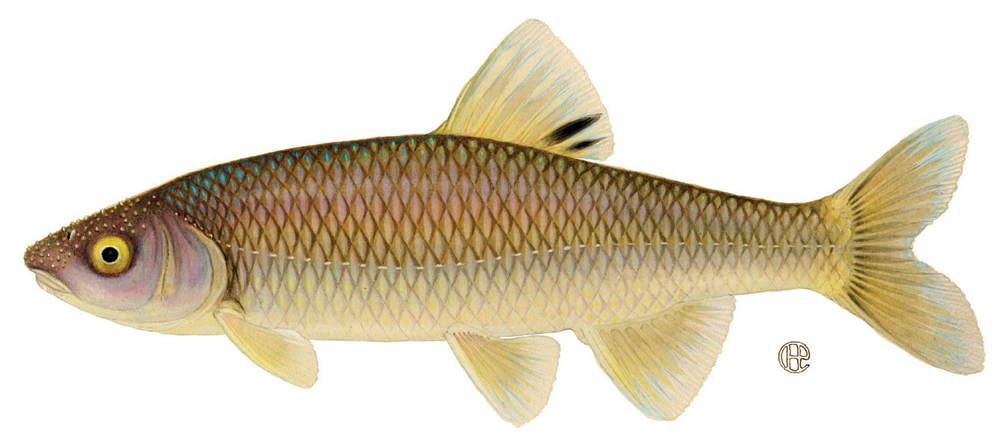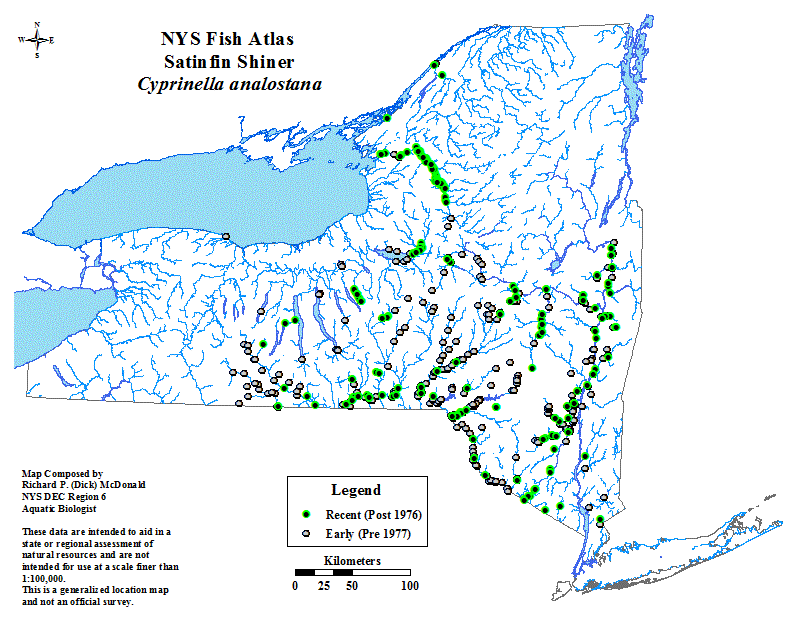
Satinfin Shiner (Cyprinella analostana)
The satinfin is an Atlantic coast species ranging from the Mohawk-Hudson to the Cape Fear River in North Carolina. In New York, it occurs in the Delaware and in the Susquehanna River and in some mid-Hudson tributaries. There are three isolated populations in the Great Lakes, one at the southern end of Cayuga Lake, one in a Lake Ontario tributary west of Rochester, and one in the Black River. These isolated populations could be remnants of former wide distributions, bait-bucket introductions or possibly canal waifs.
The satinfin shows a preference for large- and moderate-sized streams although it is occasionally taken in small creeks. It is often in the tidal freshwaters of coastal rivers.
The spawning of the satinfin was studied in wading pools near Berwick, Pennsylvania. Single pairs were placed in pools in water 150 to 200 mm deep. Black acrylic plates separated by a 3 mm space were placed on legs so they were 40 mm off the bottom. About two-thirds of the pools were covered with styrofoam sheets for shelter. Spawning began in June and continued until mid-August when it suddenly stopped. Seven pairs spawned and the eggs were collected at 2-hour intervals. Most of the spawning occurred between 6 am and noon with the peak activity between 8 am and 10 am. The spawning pairs made several passes along the crevice before releasing their eggs and several more when the eggs were sprayed into the crevices. Each spawning session lasted less than 2 hours, during which time 6 to 634 eggs were laid. Some fish produced more eggs early in the season, others later. Individual pairs spawned in 3 to 11 sessions separated by intervals of 3 to 31 days. The total number of eggs produced ranged from 381 to 3,268. Newly laid eggs were demersal, adhesive, and pale yellow in color. The size of the eggs ranged from 1.4 to 1.9 mm and varied significantly between females. The eggs laid early in the season were larger than those laid later on. Hatching took 6 to 8 days at 20 to 25 C. Newly hatched larvae were 5.9 mm long and began to feed in about 6 days.
Insects, particularly dipterans and ephemeropterans, are the main food of the satinfin.
Distribution of the satinfin shiner in NY state.
A 148 KB image of the satinfin shiner is also available for download.
The above species description was taken out of "The Inland Fishes of New York State" by C. Lavett Smith, published by the New York State Department of Environmental Conservation, 1985.
